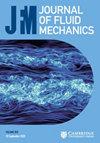On the mechanics of droplet surface crater during impact on immiscible viscous liquid pool
IF 3.6
2区 工程技术
Q1 MECHANICS
引用次数: 2
Abstract
Abstract We study drop impacts on an immiscible viscous liquid pool and investigate the formation of droplet surface craters using experimental and theoretical analyses. We attribute the formation of air craters to the rapid deceleration of the droplet due to viscous drag force. The droplet response to the external impulsive decelerating force induces oscillatory modes on the surface exposed to the air forming capillary waves that superimpose to form air craters of various shapes and sizes. We introduce a non-dimensional parameter (${\varGamma }$), that is, the ratio of the drag force to the capillary force acting on the droplet. We show that ${\varGamma }$ is directly proportional to the capillary number. We show that droplets forming air craters of significant depths have ${\varGamma }>1$. Further, we demonstrate that Legendre polynomials can locally approximate the central air crater jet profile. We also decipher that the air crater response time scale ($T$) varies as the square root of impact Weber number ($T\sim We^{1/2}$). Further, we generalize the local droplet response with a global response model for low impact energies based on an eigenvalue problem. We represent the penetrating drop as a constrained Rayleigh drop problem with a dynamic contact line. The air–water interface dynamics is analysed using an inviscid droplet deformation model for small deformation amplitudes. The local and global droplet response theories conform with each other and depict that the deformation profiles could be represented as a linear superposition of eigenmodes in Legendre polynomial basis. We unearth that the droplet response in an immiscible impact system differs from the miscible impact systems due to the presence of such a dynamic contact line.非混相黏性液池中液滴表面撞击坑的机理研究
摘要我们研究了液滴对不混溶粘性液体池的撞击,并通过实验和理论分析研究了液液滴表面凹坑的形成。我们将空气坑的形成归因于液滴由于粘性阻力而快速减速。液滴对外部脉冲减速力的响应在暴露于空气的表面上引起振荡模式,从而形成毛细管波,该毛细管波叠加以形成各种形状和大小的空气坑。我们引入了一个无量纲参数(${\varGamma}$),即作用在液滴上的阻力与毛细管力的比率。我们证明${\varGamma}$与毛细管数成正比。我们表明,形成显著深度的空气坑的液滴具有${\varGamma}>1$。此外,我们还证明了勒让德多项式可以局部近似中心空气坑喷流剖面。我们还破译了空气坑响应时间尺度($T$)随撞击韦伯数($T\sim We^{1/2}$)的平方根而变化。此外,我们基于特征值问题,用低冲击能量的全局响应模型推广了局部液滴响应。我们将穿透跌落表示为具有动态接触线的约束瑞利跌落问题。使用小变形振幅的无粘液滴变形模型分析了空气-水界面动力学。局部和全局液滴响应理论相互一致,并描述了变形轮廓可以表示为勒让德多项式基中本征模的线性叠加。我们发现,由于存在这样的动态接触线,不混溶冲击系统中的液滴响应与混溶碰撞系统不同。
本文章由计算机程序翻译,如有差异,请以英文原文为准。
求助全文
约1分钟内获得全文
求助全文
来源期刊
CiteScore
6.50
自引率
27.00%
发文量
945
审稿时长
5.1 months
期刊介绍:
Journal of Fluid Mechanics is the leading international journal in the field and is essential reading for all those concerned with developments in fluid mechanics. It publishes authoritative articles covering theoretical, computational and experimental investigations of all aspects of the mechanics of fluids. Each issue contains papers on both the fundamental aspects of fluid mechanics, and their applications to other fields such as aeronautics, astrophysics, biology, chemical and mechanical engineering, hydraulics, meteorology, oceanography, geology, acoustics and combustion.
文献相关原料
| 公司名称 | 产品信息 | 采购帮参考价格 |
|---|

 求助内容:
求助内容: 应助结果提醒方式:
应助结果提醒方式:


